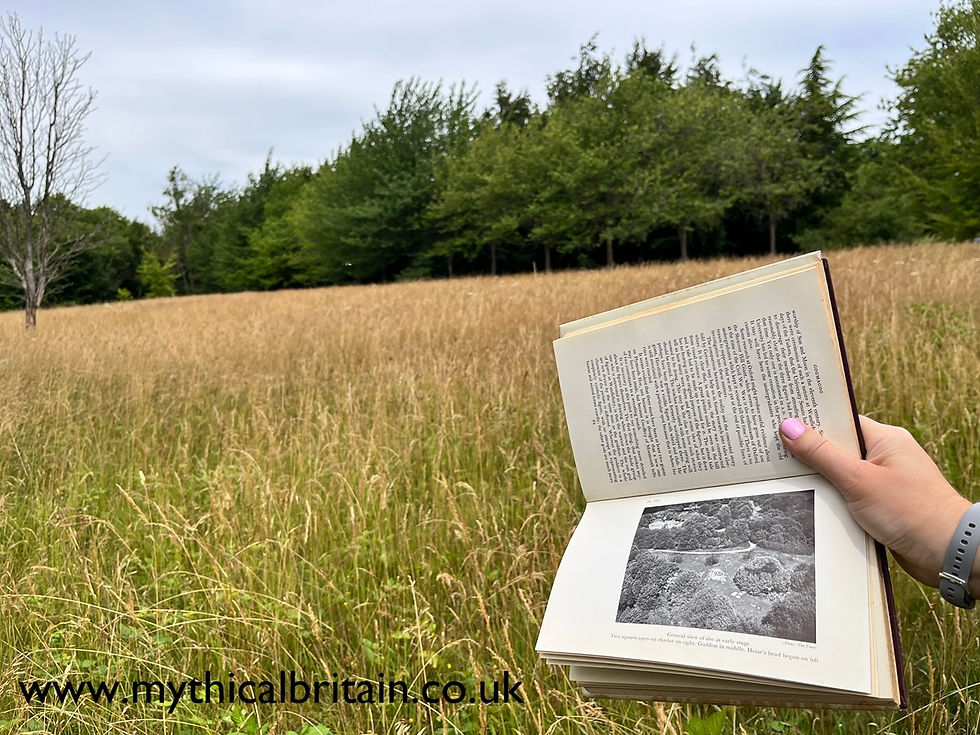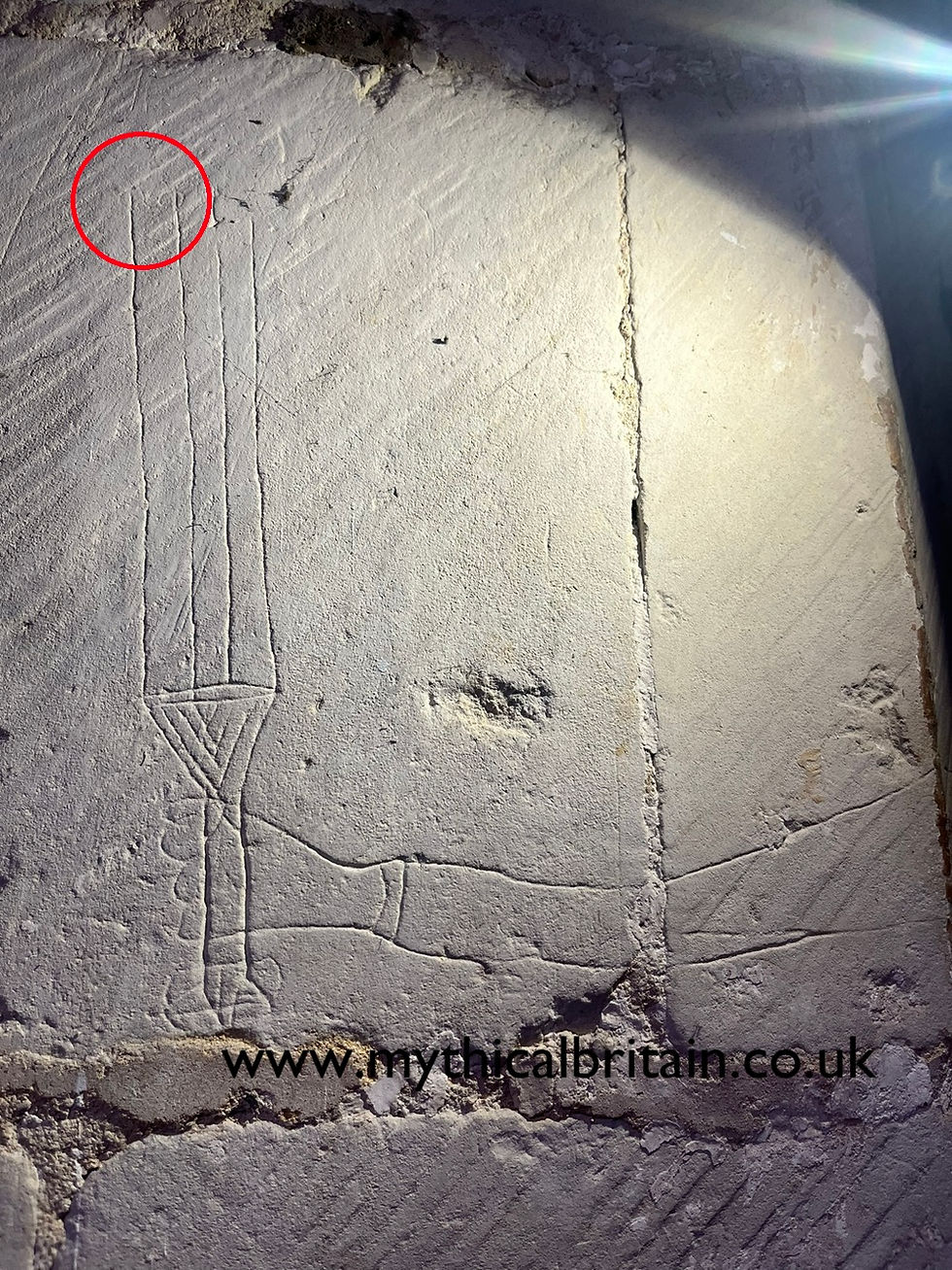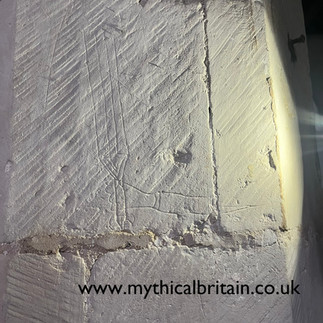T C Lethbridge and the lost Gogmagog giant of Wandlebury
- Michael Smith
- Jul 19
- 10 min read
Updated: Oct 8

In Gogmagog, the Buried Gods (1957), the archaeologist and Anglo-Saxon specialist T C Lethbridge described his excavations in search of a lost chalk giant cut into the hillside at Wandlebury Ring in the Gog Magog Hills south of Cambridge. His methods were controversial and the archaeological establishment of the time turned against him. His book is a heartfelt response to that criticism and a statement of conviction in his own work.
Chalk giants, folklore and festivity

Britain is known for its chalk giants cut into the downs of England, particularly the Cerne Abbas Giant and the Long Man of Wilmington, as well as for its chalk horses, of which that at Uffington is internationally renowned.
There were once other giants, amongst which was the giant of the Gog Magog Hills, at Wandlebury, Cambridgeshire, referred to tangentially in the correspondence of one William Cole concerning an entry in a book by a certain Bishop Joseph Hall.
In The Discovery of a New World or a Description of the South Indies, first published in Latin in 1605 and later translated into English, Hall describes a giant called “All Paunch” who, he says, is not like the “Picture the Schollers (scholars) of Cambridge goe to see at Hogmagog Hills” but instead resembles a different character in Cambridgeshire folklore.
Drawing on Hall, Cole himself says that in 1724 he also saw at Wandlebury “the figure of the giant carved on the turf”; he was often taken with his brother and sisters to see this giant by his parents. It is clear that “the” (rather than “a”) giant was a figure of importance in the area.
Morris Marples (White Horses and Other Hill Figures, 1949) argues that Hall's reference to a figure admired by scholars is suggestive of focused ritual activity. He describes (pp. 204-209) a figure possibly originally cut, maintained and celebrated by University students at Cambridge; something similar may have happened at Shotover Hill bear Oxford although the evidence for the latter is less well supported.

Seventeenth century records
Morris contends that there is no record of the name Gog Magog Hills in use before 1574, suggesting that they were named in consequence of the students' activities on the hillside with their "Gogmagog", a name long associated with giants in England.
What is less clear is whether the students may have been maintaining a figure long present since antiquity or had created the giant themselves. Lethbridge associates May fairs held at Wandlebury in the Elizabethan period with similar festivities involving the regular scouring of the Cerne Abbas giant and the Uffington horse in the same period.
Whether this is indicative of a long-standing local giant-scouring tradition going back into the depths of time is unclear although the Otai Imperialia of Gervase of Tilbury (ca. 1211) does refer to the hill being associated with a giant in local folklore .
Similarly opaque is the exact location of the figure of the giant. The Antiquarian John Layer wrote in 1640 that the giant was carved “within the said trench” (presumably within the ditches of Wandlebury hill fort; possibly flat on the ground in the manner of the turf maze at nearby Saffron Walden).
However, Morris writes that it may have been cut into the rampart of the ditch (i.e. within the ditch itself and on the higher, outward facing rampart bank) but also tells us that the construction of the great house at Wandlebury and the laying out of its gardens cut over where the site had been. If this is the case, the giant has truly been lost to time.

The giant in living memories
Samuel Cowells, a contemporary colleague of Lethbridge, recalled that as a boy he knew an old man who told him that in his own youth the giant could be viewed from nearby Sawston. Lethbridge also cites Guy Maynard, curator of Saffron Walden Museum, who also knew of old men with similar stories about the giant.
From this evidence, it seems that the last known reference to the giant as a visible figure was in the nineteenth century, perhaps ca. 1825-1850 - i.e. a date after the building of Wandlebury hall.
Beyond this date, it seems, there are no further references to the figure of the giant. What was the truth about this lost chalk giant? Could it have existed?
T C Lethbridge and the lost Gogmagog giant of Wandlebury

In Autumn 1954, seemingly prompted by Cowells’ own desire to see the giant revealed, and with the support of University authorities, Lethbridge began looking for the Wandlebury giant.
Ignoring Layer’s considerations and convinced that the giant had been visible from Sawston, he began working on a south facing slope below Wandlebury ring, on the hillside itself, rather than the rampart. As he writes (p. 23), “I was pleased to find that not more than a hundred yards of hillside seemed to fulfil the necessary conditions”
In the days before ground penetrating radar, Lethbridge used a well-proven system of sounding to help locate subterranean features such as agricultural drains. This involved using a six-foot stainless-steel bar which he thrust into the earth until it hit a solid surface.
By this laborious method, and over many months, he worked painstakingly to uncover a range of features which he then marked out with sticks on the surface. Converting these markings to continuous line drawings he sought the opinions of archaeologist friends as to their meaning.
Epona, a sun god and a warrior?
Sir Thomas Kendrick at the British Museum considered one sketch to represent the hind quarters of a galloping horse. A further tracing of a whole figure caused Sir Cyril Fox to liken it to the Celtic horse goddess Epona with two horses.
Lethbridge (p. 32) considered these elements to be new discoveries and different to the Gogmagog Giant he was seeking. Further probing with the bar led him to uncover a second figure bearing a sword and then a third, seemingly a “sun god”.

In all, Lethbridge appeared to have uncovered a whole frieze of chalk figures which, if true, would be unique to England. Such a find would be rare indeed and worthy of considerable academic examination.
His assessment was that the first “Epona” (or possibly a moon goddess) figure was earlier than the other two and that the second (swordsman) figure represented the giant of memory celebrated in local folklore.
He considered the swordsman and the sun god to be later cuttings to “Epona”. He also believed these two figures may also be the source of the fighting knights and ghostly horses referred to in the stories of Gervase of Tilbury.
Concluding his findings, Lethbridge believed that all the cuttings on the hillside at Wandlebury may have represented part of a longstanding centre for local stories which were added to over time.
His many critics disagreed, believing the features were natural rather than man made; the criticism was such that in 1957 Lethbridge published Gogmagog, The Buried Gods, in which he put forward a passionate defence of his methods and findings.
Challenges to the Lethbridge's Wandlebury Giants

In the book, Lethbridge places great emphasis on drawing the reader in, describing events in the moment and as they unraveled. Rather than being some turgid academic treatise, his style is personal and approachable. With passion and excitement, he takes the reader through what he did, the challenges he faced, and why he arrived at his conclusions.
Yet it is clear that he also profoundly believes in his archaeological method and in his discoveries. He resents accusations that his findings were no more than geological features, the result of erosion, the uprooting of trees and traces left by water cutting through the chalk. He is clearly wounded by accusations levelled against him by the establishment.
However, despite his convictions and his considerable success elsewhere using his own techniques, Lethbridge's 'frieze' is difficult to match with the written and oral record, Were they really dramatic features in an empty landscape visible for miles? Even if the trees of today are stripped away, just how visible was such a frieze, if it existed? How socially important or impressive was it?
Any visitor to the site today must accept that the slope of Wandlebury Hill – unlike that of most British chalk figures - is very shallow and only visible discreetly. Lethbridge himself concedes (p. 65) that the slope is barely 12 degrees and “it cannot easily be overlooked from elsewhere.”
Lethbridge also argues that the complexity of the frieze might even have required the artistic supervision of a master artist standing on the nearby Little Trees Hill. Such a viewing platform, he argues, may also have had the benefit of giving a different perspective of he figures than that seen rendered at ground level (p. 67).
But if this was so, how then might it have been possible for people to have seen the figures from nearby Sawston, over four miles away? Perhaps Morris's suggested "rampart" cutting made more sense, being at the highest parts of the hill?
Although Lethbridge’s map of the area (p. 8) shows Sawston on raised land (100 feet) and Wandlebury hill above 200 feet (243 feet), the figures’ relative diminutive size and position low down the hill suggest a long distance viewing was unlikely. The recollections of Cambridgeshire’s “old men” must therefore be flawed.
Yet it is unlikely that such powerful local folklore is not based somewhere in fact. The written record for the Wandlebury giant (singular) is indicative of a particular truth. Perhaps the recollections of old men were more indicative of emotional connection; they knew the chalk giant existed on the hill but perhaps not in the way they recall (i.e. visible from a distance)?
Visual evidence?
Nonetheless, Lethbridge placed great faith in oral record and what he calls "Inherent Probability"; his work was driven by his belief that the giant was visible from Sawston. He argues that a remarkable item of medieval graffiti at St Mary's church, Sawston is indicative of the giant’s longstanding and emphatic cultural impact and influence in the local area.
Lightly cut onto one of the pillars of the church is what appears to be a man in a tunic bearing a (pre-medieval) sword without the later cross guard. Lethbridge connects this with the view that the giant on the hill had been in existence for many centuries before the written record. He also believes it represents a parishioner’s drawing of the swordsman in his frieze.
He expresses gratitude to Violet Pritchard on notifying him of this graffito, although in her own work on medieval graffiti (also from 1957) she appears to distance herself from a conclusive link, despite also suggesting the image is a swordsman.

However, the sword is incomplete and the lines of what Lethbridge sees as its bladed edges end abruptly, rather than connecting at a point. Nor is the abrupt ending the result of an external influence such as a damaged portion of column or a mortar join.
Instead, two of the lines which define it conclude in small circular scratchings indicative of flame. The “sword” more likely represents a candlestick, particularly given the (albeit unconnected) religious text below which Pritchard suggests is representative of Leviticus:
Vocavit autem Moysen, et locutus est ei Dominus de [tabernaculo testimonii, dicens](Then the Lord called Moses and spoke to him from the tabernacle of the testimony, saying…)
It is also possible that the figure is not contemporary with the candlestick he holds as the hand and the handle seem to have been executed separately. There is also an element of wry humour about the composition; the figure is cut into one of the faces of the column while his arm is on another. If the item he holds is a candlestick, he appears to be holding it as if peeping from an area of darkness (one side of the column) to an area of light.

The legacy of T C Lethbridge and the Wandlebury Giants of Gogmagog
Lethbridge’s work was considered controversial in its day and his findings were rejected by the academic institutions he served and the wider archaeological community.
Although he argues passionately (and at times convincingly) against his accusers in his text, his narrative style is often casual, unacademic, wandering and confrontational to the archaeological establishment.
In the end, Gogmagog – The Buried Gods did not change the view of many that Lethbridge's chalk “giants” were nothing more than natural features and the result of a wild imagination. His book was reviewed unsympathetically and eventually his humiliation was such that he resigned his positions at Cambridge.

Had Lethbridge instead reported his excavations and their findings more objectively and studiously, and accompanied his analysis with a balanced assessment of local folklore, he may well have aroused greater academic interest in Wandlebury and its figures.
Instead, although his excavations were still visible into the late 1970s, their preservation was not seen as worthy by the University and today little can be seen above ground.
Nigel Pennick has written sympathetically about the controversies surrounding Lethbridge, demanding that his work be revisited. Certainly, the resultant wilful neglect of his excavations means that as the decades go by less and less can be done to attempt a studious reappraisal of his work.

If nothing else, Lethbridge’s work demands we take a closer look at the history and presence of the Wandlebury giant.
Let there be no doubt, its presence still looms beneath the soil. The site deserves to be revisited, its secrets deserve to be known. Lethbridge deserves some recognition for the continued interest in the giant which his work has inspired.
Photographs used in this article are the author's own, except the black and white photographs and drawings which are taken from T C Lethbridge, Gogmagog, The Buried Gods (Routledge and Kegan Paul, London, 1957).
Original linocut print of the Cerne Abbas Giant by Michael Smith available here
Further reading
Lethbridge, T. C. Gogmagog, The Buried Gods. (Routledge and Kegan Paul, London 1957)
Marples, M. White Horses and Other Hill Figures (Country Life, 1949)
Pennick, N. Wandlebury Mysteries, Cambridgeshire Ancient Mysteries Group, Occasional Paper 21 (online publication; original publication date unknown)
Pritichard, V. Medieval Graffiti (Cambridge University Press 1957)
Gallery showing the site at Wandlebury and the work of T C Lethbridge
About the author, Michael Smith

I am a British translator and illustrator of medieval literature. I am also an accomplished printmaker, with work in private collections worldwide.
My books, including a translation of Sir Gawain and the Green Knight and the Alliterative Morte Arthure, are available through all the usual outlets. My translation of The Romance of William and the Werewolf was published in 2024. All my books feature my own linocut prints as their illustrations.
To find out more about me, please click here
For more details of my books and how to purchase signed copies, click here.




































Comments